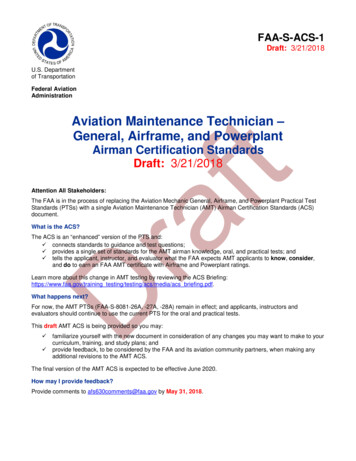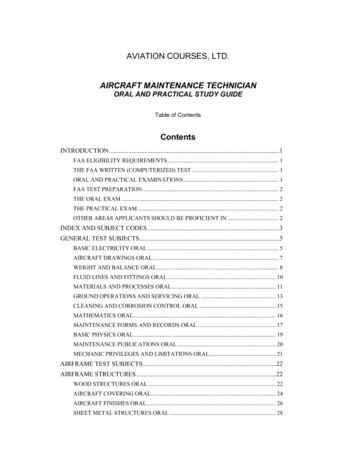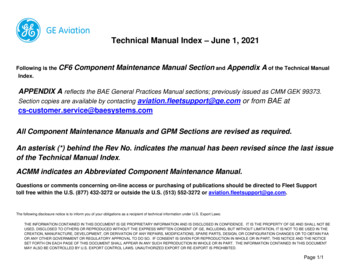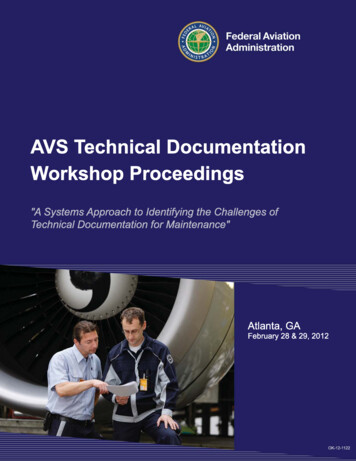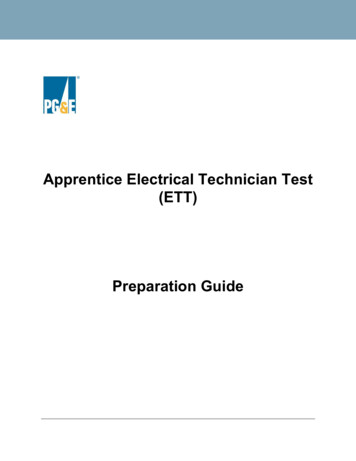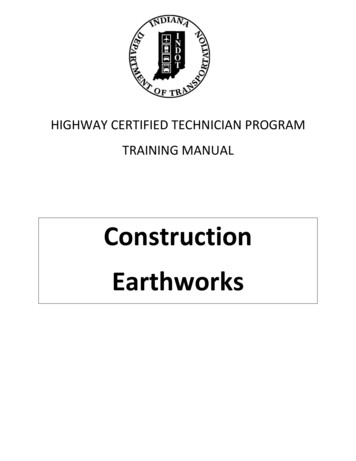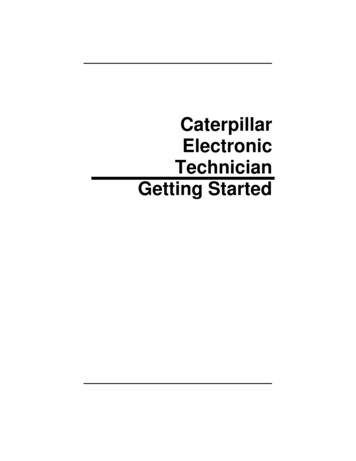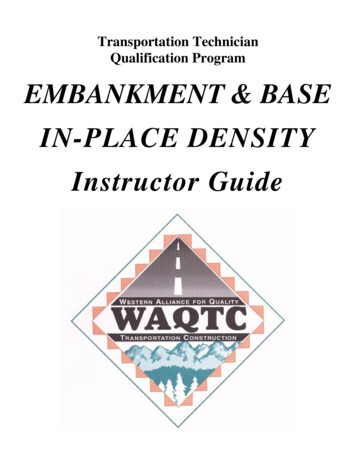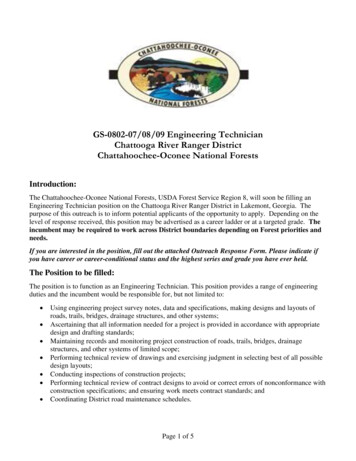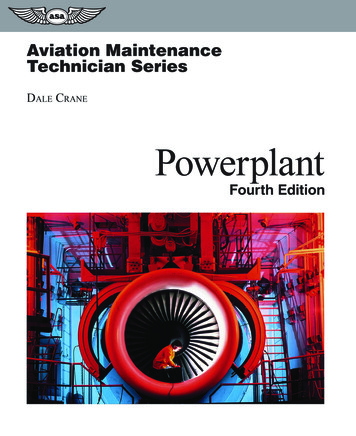
Transcription
Aviation MaintenanceTechnician SeriesPowerplantDale CraneT. David ScrogginsTechnical EditorProfessor of Applied Aviation SciencesCollege of AviationLeTourneau UniversityAviation Supplies & Academics, Inc.Newcastle, Wash ingtonFourth Edition
Aviation Maintenance Technician Series: PowerplantFourth EditionAviation Supplies & Academics, Inc.7005 132nd Place SENewcastle, Washington 98059-3153Email: asa@asa2fly.comWebsite: www.asa2fly.comVisit the Reader Resources webpage for further resources and updates to this book atwww.asa2fly.com/amtp 1996–2018 ASAAll rights reserved. Fourth Edition published 2018. First Edition published 1996.Cover photo Gary Gladstone via The Image Bank/Getty Images 2018Photo credits and acknowledgments: p. 6 — Pratt & Whitney Division, UnitedTechnologies Corp.; p. 11—The General Electric Company; p. 44—Jerry Lee Foulk;p. 46—Teledyne-Continental Motors; pp. 207, 211, 216, 219, 229—BendixElectrical Components Division; p. 494— Champion Aviation Products Division;p. 526—Instrument Technology, Inc.; pp. 527, 528—Machida, Incorporated;p. 536—Milbar Specialty Tools; p. 538—Howell Instruments, Inc.; p. 607—SundstrandCorporation; p. 709—The General Electric Company; p. 721—TEC Aviation DivisionCermicrome is a registered trademark of Engine Components, Inc.Cermisteel and CermilNil are trademarks of Engine Components, Inc.All other trademarks are registered with their respective owners.ASA-AMT-P4-PDISBN 978-1-61954-648-6iiAviation Maintenance Technician SeriesPowerplant
ContentsPreface to the Fourth EditionvAbout the Author and EditorsviiAcknowledgements123456789ixDevelopment of Aircraft Powerplants 1Reciprocating EnginesTheory & Construction 17Lubrication Systems 93Fuel Metering & Induction Systems 125Ignition Systems 205Exhaust Systems 255Cooling Systems 269Starting Systems 279Operation & Maintenance 291Turbine Engines101112131415Theory & Construction 355Lubrication & Cooling Systems 435Fuel Metering Systems 465Ignition & Starting Systems 493Exhaust Systems 515Operation & Maintenance 527Powerplant Auxiliary Systems16171819Instrument Systems 555Electrical Systems 593Fire Protection Systems 641Propellers663GlossaryIndex739775Aviation Supplies & Academics, Inc.Contentsiii
to thePrefaceFourth EditionAviation maintenance is a profession requiring a broad spectrum of skills andknowledge that is constantly evolving as new technologies are introduced.Technicians today need a solid foundation of mechanics, physics, electricity,electronics and logic, in addition to the information unique to aircraft maintenance and construction. The training material in the Aviation MaintenanceTechnician Series is chosen to reflect today’s required knowledge for theaviation maintenance technician. This material comes from a combinationof both personal experience and research. Like previous editions, this Powerplant textbook, along with the other ASA maintenance volumes, endeavorsto meet the needs of today’s technicians.ASA is dedicated to providing easy to understand training materials forthe AMT certificate applicant. The chapters are carefully chosen to reflectFAA requirements, while the arrangement of information is intended to lenditself to a Part 147 curriculum. This arrangement also provides a logical flowof information that enhances individual learning. Therefore, the AMT Seriestextbooks contribute to the knowledge necessary for the building of wellrounded aircraft technicians, who will not only be equipped to understandthe workings of aircraft systems, but will have the skills to repair, service,inspect, and troubleshoot them.Additional recommended study materials would include such materialas the FAA’s Aviation Maintenance Technician Handbook—General (FAAH-8083-30), —Airframe (FAA-H-8083-31), and —Powerplant (FAA-H8083-32), also available from ASA. ASA provides the best collection ofAMT-related federal aviation regulation reprints in FAR for Aviation Maintenance Technicians, printed yearly and provided with periodic updates on theASA website (www.asa2fly.com). For those who are preparing to take theirFAA exams, ASA’s Test Guides are an invaluable tool to test your knowledgeof aircraft maintenance.Finally, we in aviation build on the legacy of the people who came beforeus as pioneers. That was true for the early experimenters trying to get off theground for the first time just as it is true for today’s mechanics, engineers, andpilots who are building and operating jumbo jets. The principle of buildingon the legacy of others is certainly true with this textbook—Dale Crane wasthe author of many of the ASA texts. Many students over the years came totrust Dale’s authorship to not only inform, but to do so in an accurate, concise,and straight-forward manner.ContinuedAviation Supplies & Academics, Inc.v
Later, technical editors carried on that tradition by updating the book asaviation technology continued to evolve. The current technical editor neverhad the opportunity to study directly under Mr. Crane but many of his mentorsand friends began their careers in aviation as Mr. Crane’s students. Therefore,the current technical editor benefits heavily from Mr. Crane’s knowledge andability. It is the goal of this editor to carry on in the tradition of quality andclarity that Dale Crane established.T. David ScrogginsTechnical Editor for the Fourth EditionviAviation Maintenance Technician SeriesPowerplant
About the Authorand EditorsDale Crane (1923 – 2010) was involved in aviation for more than 50 years.He began his career in the U.S. Navy as a mechanic and flight engineer inPBYs. After World War II, he attended Parks Air College. After college,he worked as an instrument overhaul mechanic, instrument shop manager,and flight test instrumentation engineer. Later he became an instructor andthen director of an aviation maintenance school. Dale was active as a writerof aviation technical materials, and as a consultant in developing aviationtraining programs. ATEC presented to Dale Crane their special recognitionaward for “his contribution to the development of aviation technicians as aprolific author of specialized maintenance publications.” He also received theFAA’s Charles Taylor “Master Mechanic” award for his years of service inand contributions to the aviation maintenance industry, and the recognitionof his peers for excellence as a leader and educator in aircraft maintenance,and aviation safety advocate.T. David Scroggins, technical editor for the Fourth Edition, is a Professor ofApplied Aviation Science in the College of Aviation at LeTourneau University.He studied in Moody Bible Institute’s Aviation program obtaining his Bachelorof Science in Missionary Aviation Technology; after earning his Mechanic’scertificate in 1981, David worked in several general aviation maintenancejobs in the U.S. and overseas. He started teaching at LeTourneau Universityin 1992; in 1996 he earned his Master of Science Degree in Technology fromthe University of Texas at Tyler. At LeTourneau David teaches courses inReciprocating Engines, Turbine Engines, Propellers and Instrument Systems.He currently holds an Airframe and Powerplant Mechanic certificate, a Commercial Pilot Certificate and a Mechanic Examiner’s Designation.Technical editors for the previous editions were Pat Benton, WesternMichigan University, and Terry Michmerhuizen, Cornerstone College (Firstand Second Editions); Jerry Lee Foulk, LeTourneau University (Second andThird Editions).Aviation Supplies & Academics, Inc.vii
AcknowledgementsA series of texts such as this Aviation Maintenance Technician Series could never be compiled without the assistanceof modern industry. Many individuals have been personally helpful, and many companies have been generous withtheir information. We want to acknowledge this and say thank you to them all.ACES Systems—TEC AviationDivision, Knoxville, TNContinental Motors Group,Mobile, ALPrecision Airmotive Corporation,Everett, WAAero Quality International,Stamford, CTDowty-Rotol, Inc.,Cheltenham, EnglandQuan-Tech, Flanders, NJAero-Mach Labs, Inc., Wichita, KSDynamic Solutions Systems, Inc.,San Marcos, CASaft America, Inc., Valdosta, GAAeroquip Corporation, Jackson, MIAirborne Division, Parker HanniflinCorporation, Elyria, OHAllied Signal Aerospace, Phoenix, AZAllison Engine Company,Indianapolis, INASCO Aeronautical, Columbus, OHAviation Laboratories, Inc.,Houston, TXBarfield, Inc., Atlanta, GABeech Aircraft Corporation,Wichita, KSBendix Electrical ComponentsDivision, Sidney, NYCessna Aircraft Company,Wichita, KSChadwick-Helmuth Company, Inc.,El Monte, CAChampion Aviation ProductsDivision, Liberty, SCEngine Components, Inc.,San Antonio, TXGeneral Electric Company,Cincinnati, OHGulfstream Aerospace, Savannah, GAHamilton Standard Division of UnitedTechnologies, Windsor Locks, CTHowell Instruments, Inc.,Fort Worth, TXMachida Incorporated,Orangeburg, NYMcCauley Accessory DivisionCessna Aircraft Company,Vandalia, OHMilbar Corporation,Chagrin Falls, OHRam Aircraft Corporation, Waco, TXSlick Aircraft Products, Division ofUnison, Rockford, ILStandard Aero, Winnipeg, Manitoba,CanadaStanley-Proto Industrial Tools,Covington, GAStead Aviation Corporation,Manchester, NHSundstrand Corp., Rockford, ILSuperior Air Parts, Inc., Addison, TXTextron Lycoming, Williamsport, PATRW Hartzell Propeller ProductsDivision, Piqua, OHT.W. Smith Engine Company, Inc.,Cincinnati, OHUE Systems, Inc., Elmsford, NYNASA Lewis Research Center,Cleveland, OHUnited Technologies, Pratt & Whitney,East Hartford, CTPratt & Whitney Canada,Longueuil, Quebec, CanadaWelch Allyn Imaging Products Division,Skaneateles Falls, NYAviation Supplies & Academics, Inc.ix
1Development ofAircraft PowerplantsThe Principle of Heat Engines3External-Combustion Engines 3Internal-Combustion Engines4Aircraft Reciprocating EnginesAircraft Turbine Engines48Electrically Powered Engines11Study Questions: Development of Aircraft Powerplants 13Answers to Chapter 1 Study Questions14Development of Aircraft PowerplantsChapter 11
1Development ofAircraft PowerplantsThe first man-carrying flights were made in hot air balloons swept along byair currents and without means for the pilot to control the direction of flight.Aircraft had little practical utility until the development of engine-drivenpropellers. This development of the powerplant has made aviation the vitalfactor that it is today in the economic world.powerplant. The complete installationof an aircraft engine, propeller, and allaccessories needed for its proper function.The Principle of Heat EnginesAll powered aircraft are driven by some form of heat engine. Chemical energystored in the fuel is released as heat energy that causes air to expand. Theexpansion of this air is what performs useful work, driving either a pistonor a turbine.There are two basic types of heat engines: external-combustion andinternal-combustion.External-Combustion EnginesExternal-combustion engines are most familiar to us as steam engines. Energyreleased in coal- or gas-fired furnaces or in nuclear reactors is transferredinto water, changing it into steam that expands and drives either a piston ora turbine.Steam engines were used to power experiments in flight made during the late 1800s. Dr. Samuel Langley of the Smithsonian Institution inWashington, D.C. used small steam engines to power a successful seriesof unmanned machines he called Aerodromes. In 1896, Dr. Langley madea number of powered flights with these models. The most successful hadtandem wings with a span of 14 feet, weighed 26 pounds, and was poweredby a one-horsepower steam engine. It was launched from a catapult atop ahouseboat on the Potomac river, and flew for 90 seconds, traveling more thanhalf a mile.There was one successful but impractical aircraft steam engine developedin America in 1933 by the Besler brothers, manufacturers of logging locomotives. This 150-horsepower engine, using an oil-fired boiler and havinga total installed weight of approximately 500 pounds, was used to power aTravel Air 2000 biplane.Development of Aircraft Powerplantsheat engine. A mechanical device thatconverts chemical energy in a fuel into heatenergy, and then into mechanical energy.internal-combustion engine. A formof heat engine in which the fuel and airmixture is burned inside the engine.external-combustion engine. A form ofheat engine in which the fuel releases itsenergy outside of the engine.piston. The movable plug inside thecylinder of a reciprocating engine.turbine. A wheel fitted with vanes orairfoils radiating out from a central disk.Used to extract energy from a stream ofmoving fluid.Aerodrome. The name given byDr. Samuel Langley to the flying machinesbuilt under his supervision between theyears of 1891 and 1903.Chapter 13
Internal-Combustion EnginesOtto cycle of energy transformation. Thefour-stroke, five-event, constant-volumecycle of energy transformation used in areciprocating engine.gas turbine engine. An internal combustion engine that burns its fuel in a constantpressure cycle and uses the expansion ofthe air to drive a turbine which, in turn,rotates a compressor. Energy beyond thatneeded to rotate the compressor is used toproduce torque or thrust.turbojet engine. A gas turbine engine thatproduces thrust by accelerating the mass ofair flowing through it.turbofan engine. A type of gas turbineengine in which lengthened compressoror turbine blades accelerate air around theoutside of the core engine.turboprop engine. A turbine engine inwhich energy extracted from the accelerated gases is used to drive a propeller.turboshaft engine. A turbine enginein which energy extracted from theaccelerated gases is used to drivehelicopter rotors, generators, or pumps.reciprocating engine. A type of heatengine that changes the reciprocating(back-and-forth) motion of pistons insidethe cylinde
as the FAA’s Aviation Maintenance Technician Handbook—General (FAA-H-8083-30), —Airframe (FAA-H-8083-31), and —Powerplant (FAA-H-8083-32), also available from ASA. ASA provides the best collection of AMT-related federal aviation regulation reprints in FAR for Aviation Mainte - nance Technicians, printed yearly and provided with periodic updates on the ASA website

